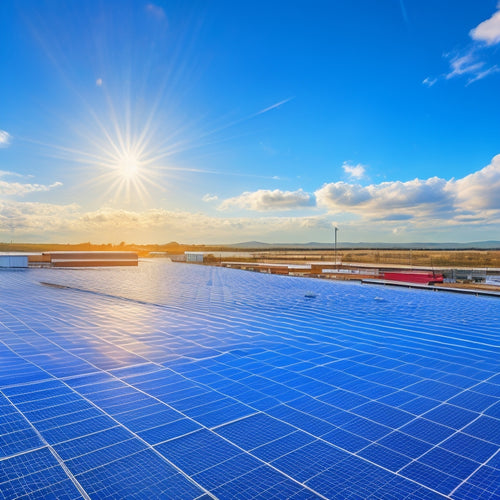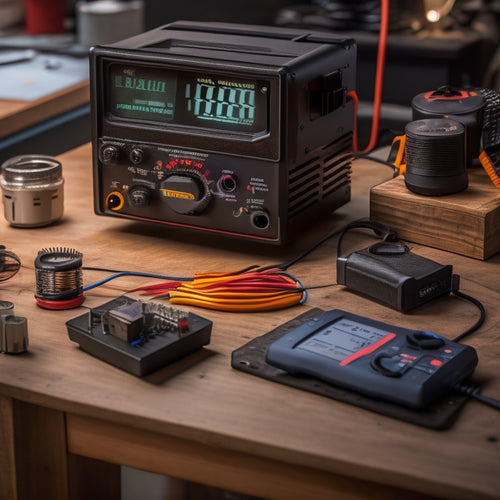
Home Energy Independence Cost Breakdown Estimates
Share
You can expect to invest between $15,000 and $30,000 in a typical residential solar panel system, depending on your energy needs, system size, and configuration. Breakdown estimates reveal that equipment and materials account for approximately 40% to 60% of total costs, with labor and installation fees representing around 30%. Permits and inspection charges add up to $2,300, depending on location and system size. Financing options and federal tax credits can help spread costs over time. As you weigh the costs and benefits, a detailed understanding of each component will help you optimize your path to home energy independence - and there's more to investigate when it comes to maximizing your investment.
Overview
- Typical residential solar panel installation costs range from $15,000 to $30,000, with financing options available to spread costs over time.
- The federal solar investment tax credit (ITC) offers a 26% reduction in upfront costs, making solar panels a more affordable option.
- Solar panels typically pay for themselves within 5-7 years through energy savings, and routine maintenance costs should be budgeted for optimal system performance.
- System size and configuration significantly impact costs, with larger systems and energy storage integration increasing upfront costs but enhancing efficiency.
- Labor and installation fees, permits, and inspection charges account for around 60% of total system costs, emphasizing the importance of careful planning and budgeting.
Solar Panel Installation Costs
Your solar panel installation costs depend on several factors, including the system size, equipment quality, and local labor rates. These variables impact the overall expense, which can range from $15,000 to $30,000 or more for a typical residential system.
Fortunately, financing options are available to help spread the cost over time. You can also benefit from tax incentives, such as the 26% federal solar investment tax credit (ITC), which can greatly reduce your upfront costs. In addition, solar panels can generate long-term energy savings, typically paying for themselves within 5-7 years.
Considering installation and labor costs and the importance of hiring skilled professionals, it's crucial to factor in these expenses into your overall budget.
Moreover, the cost of solar energy systems can be influenced by the cost per watt of different mounting and tracking systems. To guarantee peak performance, budget for routine system maintenance, which can include cleaning and inspecting your panels annually.
System Size and Configuration
As you consider financing options and tax incentives to offset the upfront costs of solar panel installation, the system size and configuration become essential factors in determining the overall expense. A properly sized system guarantees you generate enough energy to meet your needs, while an efficient configuration maximizes energy production and reduces waste.
| System Configuration | Impact on Cost |
|---|---|
| Larger system size (e.g., 10 kW) | Higher upfront cost, but potentially lower cost per watt |
| Energy storage system (ESS) integration | Increased cost, but enhanced system efficiency and backup power capabilities |
| High-efficiency panels (>20% efficient) | Higher cost, but improved system efficiency and potentially smaller system size |
| DC-DC power optimizer integration | Increased cost, but improved system efficiency and monitoring capabilities |
Optimizing your system size and configuration is vital to achieving energy independence while minimizing costs. By carefully considering these factors, you can create a customized solution that meets your energy needs and budget.
Equipment and Material Expenses
How much do the individual components of a solar panel system contribute to the overall cost?
You'll find that solar panels themselves account for about 40% of the total expense. Inverters, which convert DC power to AC, add another 15%.
Mounting hardware, wiring, and tracking systems make up around 20%. When evaluating energy storage options, consider key factors such as capacity, depth of discharge, and cycle life for energy autonomy high DOD.
Battery storage options, like lithium-ion batteries, can add 10% to 20% to the total cost, depending on the type and capacity, with top brands like Tesla and LG Chem RESU offering reliable solutions.
Energy efficiency upgrades, such as new windows or insulation, can also impact your overall expense. These upgrades can range from 5% to 15% of the total cost, depending on the scope of the project.
Understanding the cost breakdown of each component helps you prioritize your energy independence goals and make informed decisions about your system's design and features.
Labor and Installation Fees
Labor and installation fees account for around 30% of the total cost of a solar panel system, making them a significant expense in the pursuit of home energy independence.
You'll want to verify that you're getting a fair deal on these costs, as they can add up quickly. DIY installation can reduce labor costs, allowing you to allocate more resources to off-grid solar kits that cater to your specific energy needs.
A reputable installer will provide you with a detailed breakdown of their labor and installation fees, including warranty considerations and any additional services they offer.
Be certain to ask about financing options, as some installers may offer payment plans or partner with lenders to help make your system more affordable.
Permits and Inspection Charges
Your solar panel system installation requires compliance with local building codes and regulations, which necessitates obtaining permits and undergoing inspections. This process involves submitting a permit application and paying the associated fees. You'll also need to schedule inspections to guarantee your system meets the required standards.
| Permit/Inspection Type | Estimated Cost |
|---|---|
| Electrical permit | $100-$300 |
| Building permit | $200-$500 |
| Inspection fees (average 2-3 inspections) | $500-$1,500 |
| Total | $800-$2,300 |
Keep in mind that these estimates vary depending on your location, system size, and local regulations. Be sure to factor these costs into your overall budget to guarantee a smooth and compliant installation process.
Frequently Asked Questions
Can I Install Solar Panels on a Rented Property?
You can investigate solar options for your rented property by negotiating a solar lease with your landlord or seeking tenant agreements that allow for installations, but be prepared to address concerns about property modifications and lease terms.
How Often Do Solar Panels Need to Be Replaced?
You'll typically replace solar panels every 25-30 years, but with proper solar panel maintenance, their lifespan can extend up to 40 years, ensuring a reliable source of clean energy for your independence.
Are Energy Storage Systems Compatible With Grid-Tie Systems?
You'll find that energy storage systems are indeed compatible with grid-tie systems, offering benefits like backup power during outages and optimizing self-consumption, while grid tie advantages include selling excess energy back to the grid and reducing your reliance on it.
Can Solar Panels Be Installed on Metal Roofs?
You can install solar panels on metal roofs, leveraging metal roof advantages like durability and weather-tightness; however, you'll need to contemplate installation considerations like specialized mounting systems, increased weight, and potential corrosion risks.
Do Solar Panels Increase My Property's Value?
You're not sacrificing style for sustainability; in fact, a solar investment can enhance your property's value. According to data, solar-equipped homes sell for an average of 4.1% more, which a property appraisal can confirm, increasing your freedom to sell or refinance.
Ready to Buy
As you stand at the threshold of home energy independence, the cost breakdown estimates unfold like a roadmap to a self-sustaining utopia. The numbers may seem intimidating, but think of them as the bricks that pave the path to a future where you're no longer held hostage by utility bills. Like the layers of an onion, the costs peel away to reveal a nucleus of freedom, where the sun's energy is utilized to power your life.
Related Posts
-

Commercial Solar Energy
As you consider powering your business with commercial solar energy, you'll uncover it offers a triple benefit: signi...
-

Designing a Green Roof for Maximum Energy Efficiency
Designing a green roof for maximum energy efficiency involves several key strategies. Start by selecting native, drou...
-

Key Features of a DC to AC Converter
A DC to AC converter features high efficiency and conversion rates, which reduce energy costs and improve performance...


